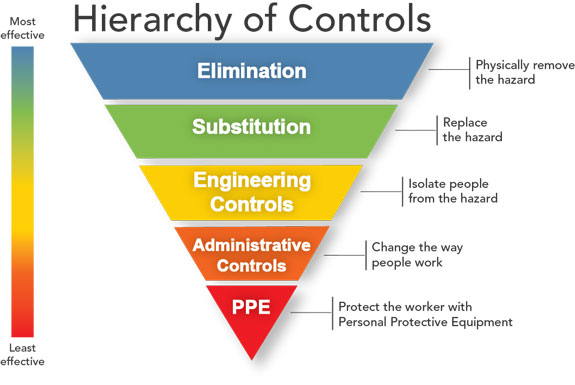In this age of COVID-19, how we do life and how we do business has changed immensely. From an industrial hygiene perspective, it raises the question of how do we protect ourselves from the virus? This is especially an important question considering the world-wide shortage of personal protective equipment (PPE).
In industrial hygiene, we follow a hierarchy of controls. Interestingly, according to the hierarchy, PPE is actually the least effective in the hierarchy.
So let’s go through each of the elements one-by-one and how it applies to COVID.
- Elimination:
Elimination would be the eradication of the infectious disease at the national or regional level. For any country or region, this would have required isolation from the outside world to ensure the disease was not brought into that nation or region to begin with. An elimination on a world-wide level would require the global extinction of the COVID19-causing virus SARS-CoV-2.
Many nations, including Canada, are beyond being able to eliminate the virus; not only is it present, but it is spreading via community transmission.
If one considers their own household though, self-isolation is a form of elimination as long as no one in your home is infected with the disease.
Shutting down non-essential businesses is another form of elimination. Not being in a place where people are gathering eliminates the exposure source for the individual. They are no longer in contact with people or surfaces that may be exposure sources.
Hand washing would be another form of elimination. It keeps the exposure source off of your body so it cannot be taken up internally and cause infection.
- Substitution:
One form of substitution is to still work, but work from home, instead of coming into the office and potentially exposing yourself to workers who may have the virus or exposing people to the virus if you have it.
This is also being done for public gatherings. Religious events and other sorts of gatherings are occurring online as a substitution to assembling together in the same building. Some musicians are currently substituting live streams for their fans instead of touring.
- Engineering:
Hospital isolation needs to be done so that contaminated areas are negatively pressured and the air coming out of that area are filtered using HEPA filtration.
In public areas, anything that prevents surface contamination is a form of engineering control. In washrooms, automatic flush toilets, soap dispensers and towel dispensers eliminate hand contact with surfaces and therefore reduce the amount of surface contamination caused by infected individuals.
- Administrative:
Procedures must be followed for donning and doffing of PPE. The Center for Disease Control in the United States gives a very helpful video for medical personnel:
https://www.utmb.edu/covid-19/health-care-workers/ppe-and-testing-information/don-and-doff-ppe
The procedures are vital so that the PPE does not cause contamination of the facial area nor inhalation of bioaerosols.
Other protocols for the general public such as limiting sizes of public gatherings are designed to lower the odds of exposure to the virus. The Canadian government is currently recommending that the public work from home if possible and limit grocery shopping to once per week.
Cleaning protocols are a vital portion of the administrative controls:
- handwashing is recommended using soap for 20 seconds
- completing surface disinfection when someone in your home is sick
Vaccination programs are considered an administrative control, and once a vaccine is developed it will be a major method of control to reduce the rate of infection.
- PPE:
Personal protective equipment includes items we wear to prevent inhalation and ingestion of the biohazard material.
Disposable gloves are worn so that the biohazard does not get on hands and the hands touch the mouth nose or eyes. Obviously, the key is that you do not touch your face with these potentially contaminated gloves and do not get hands contaminated while removing the gloves, hence the PPE donning and doffing procedures above.
To protect the eyes from getting biohazard contamination, a face shield or goggles can be worn to ensure there is a barrier if there is potential for splashing or aerosolizing of biohazard material.
Respiratory protective equipment is vital when working in close proximity to infected individuals. N95 disposable respirators are typically recommended because they filter out bioaerosols and can be disposed of when the work is complete, requiring no decontamination. It is important that the individual be fit tested to ensure the respirator is the right size for the individual and is being worn properly (see our blog post about fit testing for more information https://www.cihc.info/respirator-fit-testing-how-do-i-know-my-respirator-actually-works/).
Do you need direction for COVID19 specific to your industry or business? Certified Industrial Hygiene Consulting Ltd. Is here to help. Feel free to contact us at inquiries@cihc.info or call us at 403-543-3378.
John Howey is a Field Manager for CIHC. If you have any questions about the material covered in this blog, feel free to contact him a jhowey@cihc.info.

